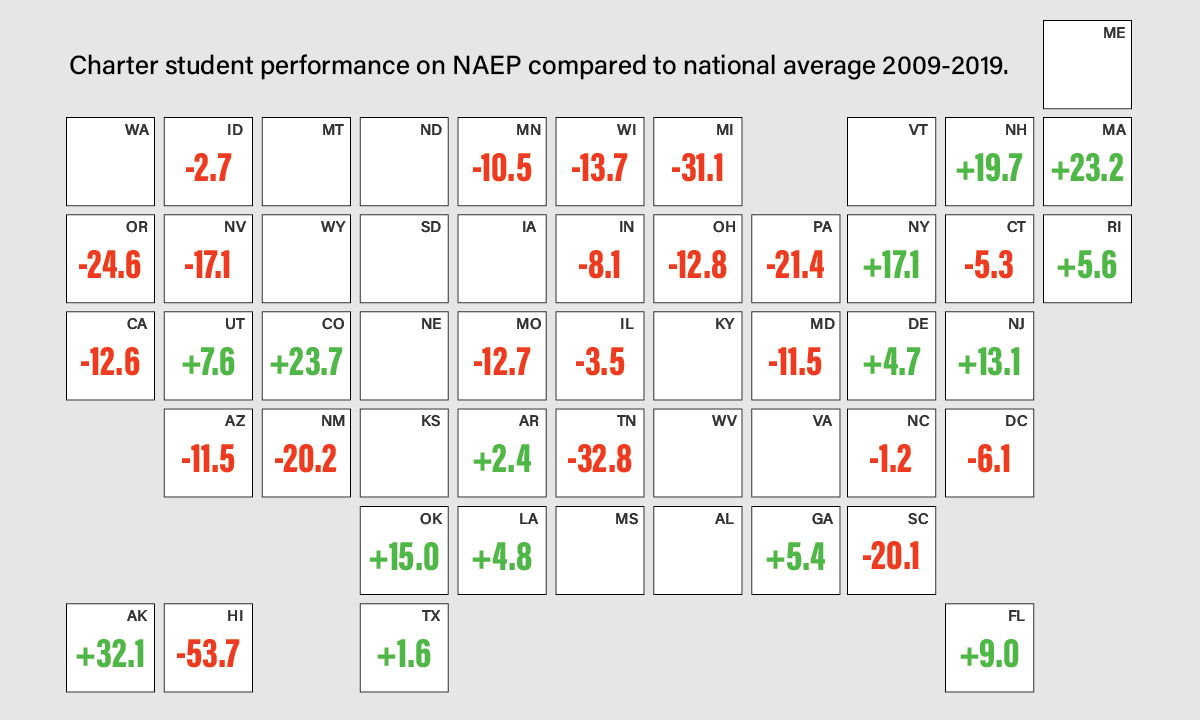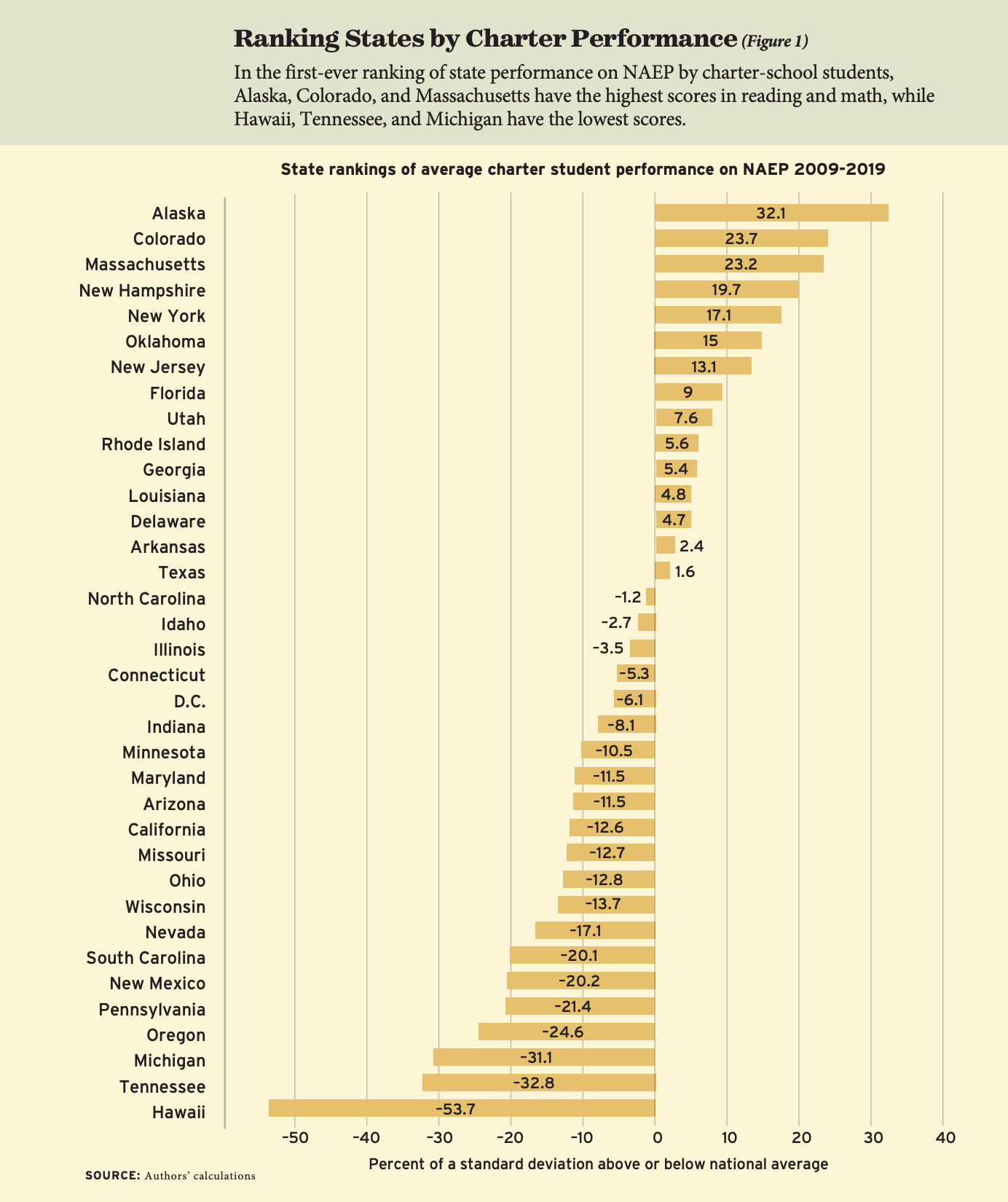Alaska Leads States in First-Ever Rankings of Charter Performance on NAEP
Harvard researchers’ examination of scores in 35 states and DC puts performance of Hawaii charters at the bottom.

In an unusual, first-of-its-kind ranking of 35 states and the District of Columbia, charter schools in Alaska turned in the highest scores in reading and math, with students there learning the equivalent of about a year’s more material than their peers in other charter schools.
Meanwhile, Hawaii appeared at the bottom, with students there learning the equivalent of a year-and-a-half less than the typical charter school student.
The study, by Paul E. Peterson and M. Danish Shakeel of Harvard University and published Tuesday in Education Next, finds that students in Alaska turned in the strongest academic performance as judged by National Assessment of Educational Progress (NAEP) tests.
Students in Colorado, Massachusetts, New Hampshire, New York, Oklahoma, and New Jersey followed closely behind, the researchers found, while charter school students in Hawaii, Tennessee, Michigan, Oregon and Pennsylvania performed the worst.
Peterson said using NAEP data for the analysis offered researchers an opportunity for a fresh, unvarnished look at charter school performance, one not often seen via state achievement tests, which for years have been criticized for manipulating proficiency levels.
NAEP, he said, is “a low-stakes test” that’s not tied to teacher pay or school rankings. And the data is “very clean because exactly the same test is being administered to every single student. So we are comparing student performances on the same tests and no other.”
The disadvantage is that the results are much more constrained than typical state tests, offering scores in just fourth and eighth grades. That makes it impossible to analyze high school performance, a key concern. But Peterson noted that most charter schools are elementary or middle schools, so the data actually capture a more accurate picture of how the sector performs.
One thing the NAEP data revealed: a serious achievement gap among charter school students in several states.
In D.C. and five states — Missouri, Wisconsin, Delaware, Michigan and Maryland — the gap between Black and white charter school students was roughly the equivalent of three-and-one-half years of learning.
They found the largest score differences between white and Hispanic students in D.C., Pennsylvania, Delaware, Georgia, Idaho and Massachusetts.
In a statement, the National Alliance for Public Charter Schools said the new data are “sobering in many respects,” showing that charter schools in many places have “room to grow.” But it said the data show “many bright spots in the charter sector, and we are especially proud of the exceptional work being done in states like Alaska, Colorado, Massachusetts, New York and Oklahoma to produce positive outcomes on NAEP.”
Peterson said he was most surprised by Alaska’s performance, but soon realized he shouldn’t be: It’s got a highly educated population and an unusual education culture. Because it’s so remote and sparsely populated, he said, correspondence schools have had a presence there since the 1930s. “And not just a few, a lot of them,” he said. “So the idea of having alternatives to the neighborhood school is very much part of their history.”
He also theorized that Alaska’s charters may have the resources to staff and equip new schools more easily than elsewhere.

As for Hawaii, he noted that half of its charter schools are explicitly serving the indigenous Hawaiian population — and half of those are teaching not in English, but in Hawaiian, as their purpose is to preserve that disappearing language.
States’ rankings based on charter students’ NAEP scores, the researchers said, were “only weakly correlated” with state rankings based on NAEP data for all public school students. And they found no significant difference in performance among states with different per-pupil charter funding levels or percentages of students enrolled in charter schools.
And though the study looked at charter schools nationally, the analysis isn’t all-encompassing.
Peterson and Shakeel looked at 145,730 NAEP results for fourth- and eighth-graders in 35 states and D.C. from 2009 to 2019, but excluded 10 states without enough data: Alabama, Iowa, Kansas, Kentucky, Maine, Mississippi, Washington, Virginia, West Virginia and Wyoming.
In five other states — Montana, Nebraska, North Dakota, South Dakota and Vermont — there were no charter schools during the time period studied.
Management, authorizers matter
The researchers also found that the type of charter school matters, as does the governmental body authorizing it.
Students in schools managed by a nonprofit network scored better on NAEP tests, while those at freestanding independent charters and for-profit charter schools did more poorly.
Though just 20% of charters are in networks, said Harvard’s Peterson, “It’s clear that if you have a network, you have more opportunities for promotion within the organization. So you can keep people for a longer period of time. You’ve got more management roles that people can grow into.”
Charter schools in networks can also share practices and standardize back office functions. “A lot of the problems that the little mom-and-pop school faces when it’s starting up, it’s got to sort of invent the whole wheel all over again.”
Who authorizes the school also matters: Students whose charter schools are authorized by a state education agency fared better than those whose schools were authorized by a school district, mayor’s office or a university. Peterson said that shouldn’t come as a surprise either, since a state department of education’s job is to supervise schools’ performance. “They have been doing this for 100 years. So if they’re now given a task to also do this for charter schools, they have the institutional capacity to do it. If you ask a university to do it, the university has never done this before. So they’re probably not going to be likely to have the equipment to do a great job of it.”
Shavar Jeffries, CEO of the KIPP Foundation, which supports the U.S.’s largest public charter school network, said the new findings “confirm our experience, which is that public charter schools perform better when they are part of a larger network.”
The new analysis differs from the recent Stanford University CREDO study, which compared charter school performance to that of students in nearby district schools. In its statement, the alliance said the CREDO study affirms that students who attend charter schools “generally have better academic outcomes when compared to their peers at nearby district schools. And we maintain our commitment to serving all students well, especially those who have been chronically underserved.”
Get stories like these delivered straight to your inbox. Sign up for The 74 Newsletter



